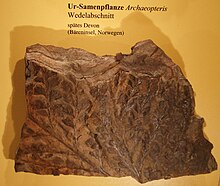Loading AI tools
Extinct class of vascular plants From Wikipedia, the free encyclopedia
The progymnosperms are an extinct group of woody, spore-bearing plants that is presumed to have evolved from the trimerophytes, and eventually gave rise to the gymnosperms, ancestral to acrogymnosperms and angiosperms (flowering plants).[1] They have been treated formally at the rank of division Progymnospermophyta or class Progymnospermopsida (as opposite). The stratigraphically oldest known examples belong to the Middle Devonian order the Aneurophytales, with forms such as Protopteridium, in which the vegetative organs consisted of relatively loose clusters of axes.[2] Tetraxylopteris is another example of a genus lacking leaves. In more advanced aneurophytaleans such as Aneurophyton these vegetative organs started to look rather more like fronds,[3] and eventually during Late Devonian times the aneurophytaleans are presumed to have given rise to the pteridosperm order, the Lyginopteridales. In Late Devonian times, another group of progymnosperms gave rise to the first really large trees known as Archaeopteris. The latest surviving group of progymnosperms is the Noeggerathiales, which persisted until the end of the Permian.[4]
| Progymnosperm Temporal range: | |
|---|---|
 | |
| Archaeopteris fossil leaves | |
| Scientific classification | |
| Kingdom: | Plantae |
| Clade: | Tracheophytes |
| Class: | †Progymnospermopsida |
| Orders | |
| |
Other characteristics:
Progymnosperms are a paraphyletic grade of plants.[5][6][7]
|
Progymnosperms |
Seamless Wikipedia browsing. On steroids.
Every time you click a link to Wikipedia, Wiktionary or Wikiquote in your browser's search results, it will show the modern Wikiwand interface.
Wikiwand extension is a five stars, simple, with minimum permission required to keep your browsing private, safe and transparent.